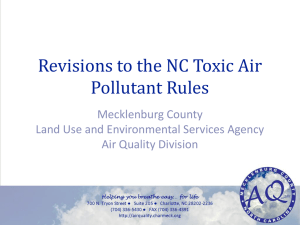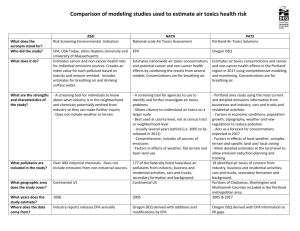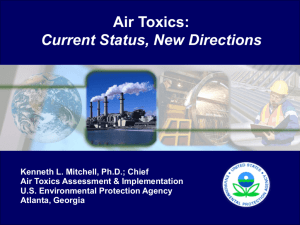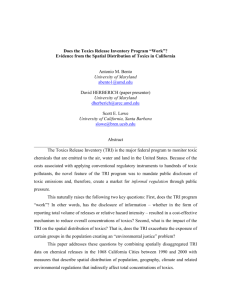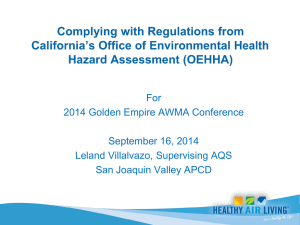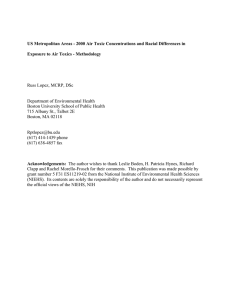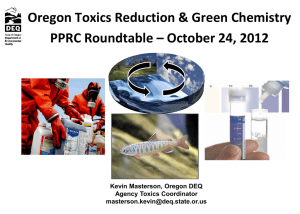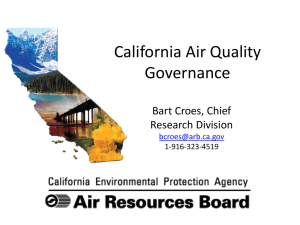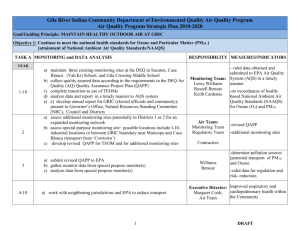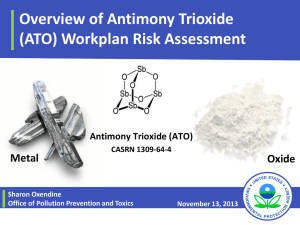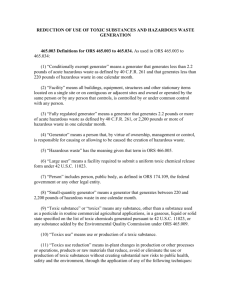Presentation () - Division of Air Quality
advertisement
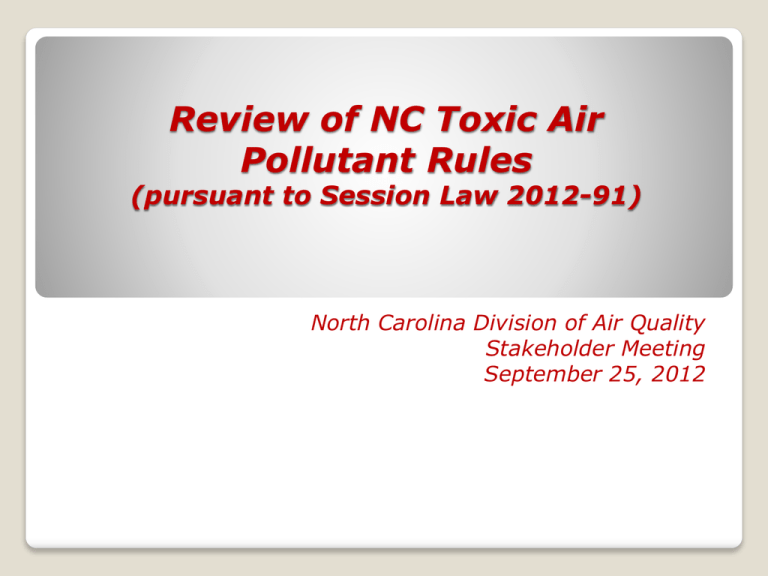
Review of NC Toxic Air Pollutant Rules (pursuant to Session Law 2012-91) North Carolina Division of Air Quality Stakeholder Meeting September 25, 2012 History: Environmental Review Commission (ERC) meetings (Sept/Oct 2011) Working group formed (Oct 2011) Bill introduced, HB 952 (May 2012) Became law, SL 2012-91 (June 28, 2012) Air Toxics – Summary Section 1 ◦ Exempts sources subject to certain federal regulations ◦ Codifies “Director’s Call” provision Section 2 ◦ Requires rule amendments Section 3 ◦ Requires review of rules and their implementation Section 4 ◦ Requires reports on implementation of this act Air Toxics – Section 1 Exempts from the State air toxics rules sources of toxic air pollutants subject to certain federal regulations, including: National Emission Standards for Hazardous Air Pollutants (NESHAPs), 40 CFR Part 61 Maximum Achievable Control Technology (MACT) standards, 40 CFR Part 63 Generally Available Control Technology (GACT) standards, 40 CFR Part 63 Subject to case-by-case MACT, 112(j) of the Clean Air Act Air Toxics – Section 1 When DAQ receives a permit application for a new or modified source or facility that would result in a net increase in toxic air pollutants: ◦ Requires DAQ to determine if the toxic air emissions would pose an unacceptable risk to human health… and if it does, the Division Director would make a written finding and require a permit application that eliminates the unacceptable risk… (for all practical purposes this is the existing Director’s Call provision) Example Illustrating State and Federal Air Toxics Programs ABC Company 2 Source 1 NOT Regulated by Federal Air Toxics Rules Source 2 Regulated by Federal Air Toxics Rules 1 3 Property Line Source 3 NOT Regulated by Federal Air Toxics Rules Source: DENR-DAQ Air Toxics – Section 2 Requires the Environmental Management Commission (EMC) to amend the State air toxics rules to be consistent with Section 1 above. Air Toxics – Section 3 Requires DAQ to review the State air toxics rules and their implementation to determine whether changes could: ◦ Reduce unnecessary regulatory burden ◦ Increase the efficient use of DAQ resources while maintain protection of public health DAQ shall report the results of the review and include recommendations to the ERC by December 1, 2012 Air Toxics – Section 4 Requires DAQ report to the ERC on the implementation of this Act ◦ December 1, 2012, 2013 and 2014 ◦ The report shall include an analysis of air toxic emission changes and a summary of results of the Division’s analysis of air quality impacts. Link to SL 2012-91 http://www.ncleg.net/Sessions/2011/Bills/House/PDF/H952v4.pdf Section 3 review The Division of Air Quality of the Department of Environment and Natural Resources shall review toxic air pollutant rules adopted pursuant to G.S. 143-215.107(a) and the implementation of those rules to determine whether changes could be made to the rules or their implementation to reduce unnecessary regulatory burden and increase the efficient use of Division resources while maintaining protection of public health. The Division shall conduct this review in consultation with interested parties. The Division shall report the results of its review, including recommendations, if any, to the Environmental Review Commission no later than December 1, 2012. Section 3 review For each of the options we discuss, consider whether it: ◦ reduces unnecessary regulatory burden ◦ increases the efficient use of Division resources ◦ maintains protection of public health Options to Discuss The following options may fit the criteria laid out in SL 2012-91. Options have evolved from comments from the regulated community and DAQ’s experience implementing the air toxics rules. This is not an exhaustive list of options… it’s intended to stimulate discussion. Feel free to comment on these options or submit additional ideas that are consistent with SL 2012-91. Options to Discuss 1. 2. 3. 4. 5. 6. 7. Re-evaluate toxic permitting emission rates (TPERs) Exempt natural gas and propane combustion units Exempt emergency engines Register rather than permit sources less than certain emissions thresholds Do not retain SIC call Maximum Feasible Control = Maximum Achievable Control Evaluate projected actual emissions 1. Re-evaluate toxic permitting emission rates (TPERs) What are TPERs? TPERs are established in rule 15A NCAC 02Q .0711 and are backcalculated from the Acceptable Ambient Level (AAL) guidelines. Conservative assumptions are used regarding stack and dispersion characteristics. 1. Re-evaluate toxic permitting emission rates (TPERs) How are TPERs used in the permitting process? Two step evaluation process: ◦ Sum all non-exempt toxics emissions and compare to TPER. If below TPER, done. If above TPER, modeling is necessary to compare to the Acceptable Ambient Level (AAL). 1. Re-evaluate toxic permitting emission rates (TPERs) What could change? An analysis could be done with the most recent air dispersion model and revised, but yet conservative assumptions about stack parameters, to see if any TPERs can be increased while still providing an ample margin of safety. ◦ e.g. - decrease stack diameter from 1.0 meter, or increase stack exist velocity of 0.01 m/s. 2. Exempt natural gas and propane combustion units US EPA has exempted certain gas-fired combustion units from federal air toxics rules. Another federal rule only prescribes work practice standards on affected units. Toxic air emissions from these sources are well below the TPERs. 3. Exempt emergency engines US EPA federal air toxics rules apply to all emergency engines and only prescribe work practice standards. Used temporarily in emergency situations. Small. Few hours of operation. Peak shaving engines are not considered emergency engines. 4. Register rather than permit sources less than certain emissions thresholds Considerable time and resources spent on determining if small emissions sources qualify as exempt or insignificant. Effort is disproportionate with the environmental impact. Simplify permit exemptions rule. 5. Do not retain SIC call 15A NCAC 02Q .0705 provides a mechanism for the Director to require all facilities under the same four-digit Standard Industrial Classification (SIC) to submit an application to comply with the NC air toxics rules. The existing Director’s Call rule and SL 2012-91 provide adequate authority to address any unacceptable risks to human health from any facility. 6. Maximum Feasible Control = Maximum Achievable Control Maximum feasible control as a compliance option. The director can allow maximum feasible control in certain situations. This option would allow compliance with a federal Maximum Achievable Control Technology rule to satisfy maximum feasible control requirements in the state rules. 7. Evaluate projected actual emissions The option can be clarified in the rule to ensure that DAQ is implementing it consistently. Evaluating projected actual emissions provides a more realistic evaluation of the impacts of air toxics in ambient air, particularly when considering how the TPERs and AALs guidelines are developed. Ideas? Please submit written comments by October 9, 2012 to: daq.publiccomments@ncdenr.gov Rules: http://www.ncair.org/rules/rules/Sec1100.shtml and http://www.ncair.org/rules/rules/SecQ0700.shtml North Carolina Division of Air Quality Sheila Holman Director North Carolina Division of Air Quality Mike Abraczinskas Deputy Director Sheila.Holman@ncdenr.gov 919-707-8430 Michael.Abraczinskas@ncdenr.gov 919-707-8447
